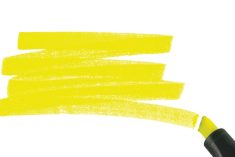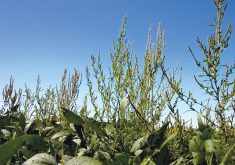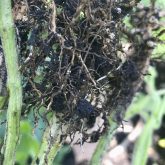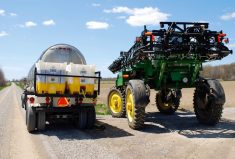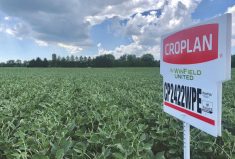The invasion continues. From 2010 to 2015, glyphosate-resistant Canada fleabane spread from Windsor to the Quebec border — more than 800 kilometres in just six years. Along the way, it evolved resistance to Groups 2 and 9 modes of action.
Waterhemp has also spread rapidly, with biotypes resistant to Groups 2, 4, 9, 14 and 27 now found in 18 counties in Ontario, up from 15 in 2022.
Those are troubling challenges for growers, including those planting the latest Roundup Xtend and E3 soybean technologies. The good news is there are still post-emergence choices for adequate, if not excellent weed control. However, those growing identity-preserved (IP) soybeans and Roundup Ready varieties face the prospect of just one option: the need for perfect or near-perfect pre-plant or pre-emergent control, especially of glyphosate-resistant Canada fleabane.
Read Also

Producers aren’t panicking over tariffs and trade threats
The influence of tariff and trade uncertainity on farm business decisions.
“If you go to IP soybean, you really have to control (Canada fleabane) — and this is also true of Roundup Ready — where you need to have 100 per cent control before the soybean comes out of the ground,” says Peter Sikkema, weed scientist at University of Guelph’s Ridgetown Campus. “We have nothing post-emergence to control glyphosate-resistant Canada fleabane in either IP or Roundup Ready soybean.”
Based on his studies, Sikkema found growers with IP and Roundup Ready crops could achieve 93 per cent control on average using Roundup + Eragon + metribuzin + Merge. Metribuzin is an active ingredient in products such as Bifecta, Boundary, Canopy PRO, Conquest, Sencor, Tricor and Triactor. In many of his studies, they achieved 100 per cent control, and plots stayed clean until harvest.
Perfect control needed
And Sikkema says 100 per cent is the objective.
“When I started … in the mid-1990s, among weed scientists at that time, if you had perfect weed control, some people would say you spent too much money on herbicides.” Ninety-five per cent control was considered good enough. In 2023, I’m rapidly gravitating to having perfect weed control so we don’t get any weed seeds returned to the soil.”

He says that can’t be underscored enough. If there is 100 per cent control and no weed seed return, there can be no selection for herbicide resistance because there is no “next generation” of seed to contaminate a field the following year.
Recent higher prices also underscore the importance of weed control. Sikkema refers to poor weed management as “leaving money on the table.”
“In the trials we’ve done, the average yield loss in soybean due to glyphosate-resistant Canada fleabane interference is 61 per cent in experiments conducted on farms in Ontario. In our most competitive environments, it’s up to 99 per cent. In soybean, the latest numbers I hear … some people are getting close to $20 per bushel. If you have 50 bushels per acre at $20, that’s $1,000 per acre but with a 61 per cent yield loss, you’re losing $610 per acre.”
The importance of managing fleabane is magnified because it grows as a winter and a summer annual. If it’s in a no-till operation and the weeds are up before soybean planting, it’s very competitive. Add waterhemp, another challenging weed species, and growers face a significant one-two punch in managing herbicide resistance. Since waterhemp is a summer annual weed that begins emerging in May and continues to germinate well into fall, the need for season-long control is imperative.
Think five years ahead
Sikkema says the need for timely herbicide applications and reducing weed seed returns to the soil requires switching from a reactive to a proactive approach. That may require a shift in thinking for many growers — from a one-year to a five-year plan.
“Whether you’re a corn, soybean or dry bean grower, regardless of the weed species on your farm, you should have a planned, two-pass weed control program and multiple herbicide modes of action in that program,” he adds. “The goal has to be zero weed seeds returned to the soil. It is really important to identify your weeds and knowing which species you have in each field. You have to adjust your weed management program based on the species composition in each field.”
As challenging as it may be to grow IP or Roundup Ready soybeans, the pressure is nonetheless different for those opting to plant Roundup Xtend and E3 soybean technologies. Although these traited varieties provide more weed management options, growers must be diligent in use of dicamba or 2,4-D because of the potential for off-target movement and injury to sensitive crops in adjacent fields. That’s where those five-year crop and weed management programs come in to build diversity, minimize selection intensity for additional herbicide-resistant weed biotypes and reduce the risk of damaging relations with neighbours.
“Farmers need to plan what crops they’re going to grow and their weed management program,” Sikkema says. “If they’re using a Group 2 or a Group 14 herbicide four or five times over a long-term program, they should try to reduce that and introduce more diversity. It’s not just ‘What am I going to do in 2023?’ It’s ‘If I do this in 2023, how will that impact what I do in 2024, ’25, ’26 and ’27?’”
It isn’t just the prospect of losing money to poorer weed management: it’s also facing the loss of tools which will increase the challenge of weed management even more in the future.
– This article was originally published in the 2023 edition of the Soybean Guide.




